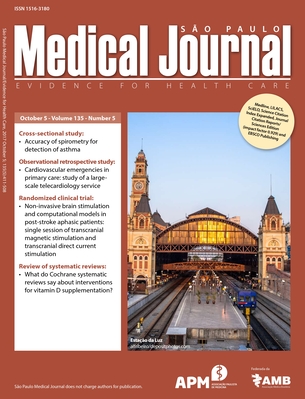Non-invasive brain stimulation and computational models in post-stroke aphasic patients
single session of transcranial magnetic stimulation and transcranial direct current stimulation. A randomized clinical trial
Keywords:
Aphasia, Stroke, Speech disorders, Transcranial direct current stimulation, Transcranial magnetic stimulationAbstract
CONTEXT AND OBJECTIVE: Patients undergoing the same neuromodulation protocol may present different responses. Computational models may help in understanding such differences. The aims of this study were, firstly, to compare the performance of aphasic patients in naming tasks before and after one session of transcranial direct current stimulation (tDCS), transcranial magnetic stimulation (TMS) and sham, and analyze the results between these neuromodulation techniques; and secondly, through computational model on the cortex and surrounding tissues, to assess current flow distribution and responses among patients who received tDCS and presented different levels of results from naming tasks. DESIGN AND SETTING: Prospective, descriptive, qualitative and quantitative, double blind, randomized and placebo-controlled study conducted at Faculdade de Ciências Médicas da Santa Casa de São Paulo. METHODS: Patients with aphasia received one session of tDCS, TMS or sham stimulation. The time taken to name pictures and the response time were evaluated before and after neuromodulation. Selected patients from the first intervention underwent a computational model stimulation procedure that simulated tDCS. RESULTS: The results did not indicate any statistically significant differences from before to after the stimulation. The computational models showed different current flow distributions. CONCLUSIONS: The present study did not show any statistically significant difference between tDCS, TMS and sham stimulation regarding naming tasks. The patients’ responses to the computational model showed different patterns of current distribution.
Downloads
References
Wassermann EM. Risk and safety of repetitive transcranial magnetic stimulation: report and suggested guidelines from the International Workshop on the Safety of Repetitive Transcranial Magnetic Stimulation, June 5-7, 1996. Electroencephalogr Clin Neurophysiol. 1998;108(1 ):1 -16.
Nitsche MA, Liebetanz D, Antal A, et al. Modulation of cortical excitability by weak direct current stimulation-technical, safety and functional aspects. Suppl Clin Neurophysiol. 2003;56:255-76.
Murase N, Duque J, Mazzocchio R, Cohen LG. Influence of interhemispheric interactions on motor function in chronic stroke. Ann Neurol. 2004;55(3):400-9.
Takeuchi N, Chuma T, Matsuo Y, Watanabe I, Ikoma K. Repetitive transcranial magnetic stimulation of contralesional primary motor cortex improves hand function after stroke. Stroke. 2005;36(12):2681 -6.
Takeuchi N, Izumi S. Noninvasive brain stimulation for motor recovery after stroke: mechanisms and future views. Stroke Res Treat. 2012;2012:584-727.
Martin PI, Naeser MA, Ho M, et al. Overt naming fMRI pre- and post-TMS: Two nonfluent aphasia patients, with and without improved naming post-TMS. Brain Lang. 2009;111 (1):20-35.
Williams JA, Imamura M, Fregni F. Updates on the use of non-invasive brain stimulation in physical and rehabilitation medicine. J Rehabil Med.2009;41(5):305-11.
Baker JM, Rorden C, Fridriksson J. Using transcranial direct-current stimulation to treat stroke patients with aphasia. Stroke. 2010;41(6):1229-36.
Weiduschat N, Thiel A, Rubi-Fessen I, et al. Effects of repetitive transcranial magnetic stimulation in aphasic stroke: a randomized controlled pilot study. Stroke. 2011 ;42(2):409-15.
Datta A, Baker JM, Bikson M, Fridriksson J. Individualized model predicts brain current flow during transcranial direct-current stimulation treatment in responsive stroke patient. Brain Stimul. 2011 ;4(3):169-74.
Hegde MN. Hegde’s Pocket Guide to assessment in speech-language pathology.Toronto: SingularThompson Learning; 2001.
Mac-Kay APMG. Afasia. In: Mac-Kay APMG, Assencio-Ferreira VJ, Ferri-Ferreira TMS, eds. Afasias e demêndas: avaliação e tratamento fonoaudiolögico. São Paulo: Editora Santos; 2003. p. 47-59.
Ortiz KK. Afasia. In:OrtizKK,editor. Distúrbios neurológicos adquiridos. São Paulo: Editora Manole; 2005. p. 47-64.
Herwig U, Satrapi P, Schönfeldt-Lecuona C. Using the international 10-20 EEG system for positioning of transcranial magnetic stimulation. Brain Topogr. 2003;16(2):95-9.
Kobayashi M, Pascual-Leone A. Transcranial magnetic stimulation in neurology. Lancet Neurol. 2003;2(3):145-56.
Kaplan EF, Goodglass H,Weintraub S.The Boston Naming Test. 2nd ed. Philadelphia: Lea & Febiger; 1983.
Datta A, Bansal V, Diaz J, et al. Gyri-precise head model of transcranial direct current stimulation: improved spatial focality using a ring electrode versus conventional rectangular pad. Brain Stimul. 2009;2(4):201-7,207.e1.
Datta A, Bikson M, Fregni F. Transcranial direct current stimulation in patients with skull defects and skull plates: high-resolution computational FEM study of factors altering cortical current flow. Neuroimage. 2010;52(4):1268-78.
Monti A, Cogiamanian F, Marceglia S, et al. Improved naming after transcranial direct current stimulation in aphasia. J Neurol Neurosurg Psychiatry. 2008;79(4):451-3.
Flöel A, Rösser N, Michka O, Knecht S, Breitenstein C. Noninvasive brain stimulation improves language learning. J Cogn Neurosci. 2008;20(8):1415-22.
Kakuda W, Abo M, Momosaki R, Morooka A. Therapeutic application of 6-Hz-primed low-frequency rTMS combined with intensive speech therapy for post-stroke aphasia. Brain Inj. 2011 ;25(12):1242-8.
Barwood CH, Murdoch BE, Riek S, et al. Long term language recovery subsequent to low frequency rTMS in chronic non-fluent aphasia. NeuroRehabilitation. 2013;32(4):915-28.
Thiel A, Hartmann A, Rubi-Fessen et al. Effects of noninvasive brain stimulation on language networks and recovery in early poststroke aphasia. Stroke. 2013;44(8);2240-6.
Cotelli M, Fertonani A, Miozzo A, et al. Anomia training and brain stimulation in chronic aphasia. Neuropsychol Rehabil. 2011:21 (5):717-41.
Barwood CH, Murdoch BE, Whelan BM, et al. Improved receptive and expressive language abilities in nonfluent aphasic stroke patients after application of rTMS: an open protocol case series. Brain Stimul. 2012:5(3):274-86.
Marangolo P, Fiori V, Calpagnano MA, et al. tDCS over the left inferior frontal cortex improves speech production in aphasia. Front Hum Neurosci. 2013;7:539.
Hamilton RH, Sanders L, Benson J, et al. Stimulating conversation: enhancement of elicited propositional speech in a patient with chronic non-fluent aphasia following transcranial magnetic stimulation. Brain Lang. 2010;113(1 ):45-50.
Fiori V, Coccia M, Marinelli CV, et al. Transcranial direct current stimulation improves word retrieval in healthy and nonfluent aphasie subjects. J Cogn Neurosci. 2011;23(9):2309-23.
Santos MD, Gagliardi RJ, Mac-Kay AP, et al. Transcranial direct-current stimulation induced in stroke patients with aphasia: a prospective experimental cohort study. Sao Paulo Med J. 2013;131 (6):422-6.
Sollmann N, PichtT, Mäkelä JP, et al. Navigated transcranial magnetic Stimulation for preoperative language mapping in a patient with a left frontoopercular glioblastoma. J Neurosurg. 2013;118(1 ):175-9.
Hamilton RH, Chrysikou EG, Coslett B. Mechanisms of aphasia recovery after stroke and the role of noninvasive brain stimulation. Brain Lang. 2011;118(1-2):40-50.






